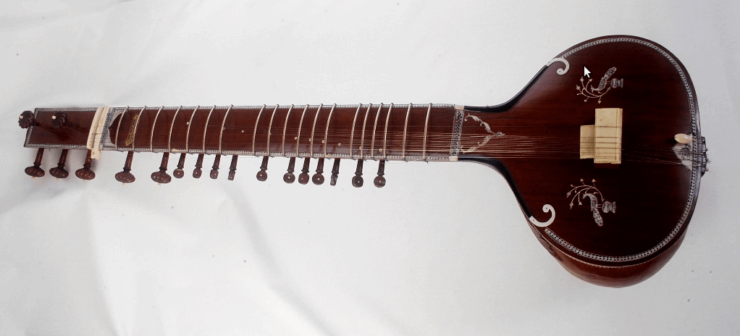A traditional Indian instrument, the sitar can have up to 20 strings, seven of which are played and the remainder act as “sympathy” strings giving the sitar its unique sound. The sitar is believed to have evolved into its current form around the 1700s and particularly prevalent to classical Indian music, especially in the Northern region of Hindustani.
Beginners beware: Whilst playing the sitar can be immensely enjoyable, after sitting down in a cross legged fashion for a considerable amount of time standing up can be extremely difficult!
Tuning
Tuning each of the 7 strings of the sitar, push each peg into its hole, thus tightening the peg to stop it slipping out of tune.
Ravi Shankar’s method of tuning the sitar is now the generally recognised technique, however it is different from the common system found in India. In Indian common tuning, strings 2 & 3 are both tuned to C, with the following 4th string a G.
In Ravi Shankar’s tuning the 2nd string is C, 3rd is G and 4th is lower C, an octave below the 2nd string.
Bending strings
Predominantly performed on the 1st string, bending on a sitar is designed to be done across multiple frets across the curved fretboard.
Indian musicians believe that whilst playing the sitar players must feel the music, therefore allowing creative imagination to decide which notes to bend to.
Using the Mezrab
The Mezrab is a sitar plectrum, worn on the the right index finger. A long, pointed metal wire covers the nail and hooks itself under the finger.
Different sized Mezrab can be purchased depending on finger size – choosing one that is too big will undoubtedly fall off and inconvenience playing.
Factors to look out for when purchasing a sitar:
- The depth and clarity of the carving should be clean and deep
- General rule: older sitars are better quality, often made from Indian mahogany or Burmese teak
- Quality meend. The ability to bend or pull the main string for a wide range of notes is a crucial element of a sitar. The best sitars have a meend range of 5 steps, from the tonic note to the fifth.
- Always get a case! Sitars are delicate instruments, they need care and attention.
- The frets should be rather thick, tied on tightly with thread. The frets of cheap sitars are often tied on with nylon fishing line. Before purchasing, make sure that a reputable dealer will retie the frets using strong thread.
Sources
- http://www.thomasvoigt.de/en/sitar.html]
- https://www.lastminutemusicians.com/search/indian_bollywood_bands.html
- http://www.livemint.com/Leisure/KykmttGeLlEeNZHDmkxPXJ/Ravi-Shankar-10-interesting-facts.html
- http://yellowbellmusic.com/instruments/string/history_sitar.php
Do you play the sitar? Perhaps you have some tips for beginners? Let us know in the comments below!
Share this:



















